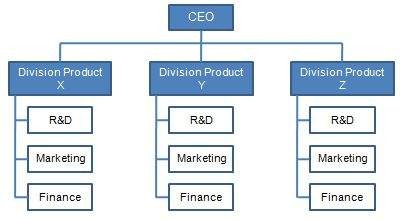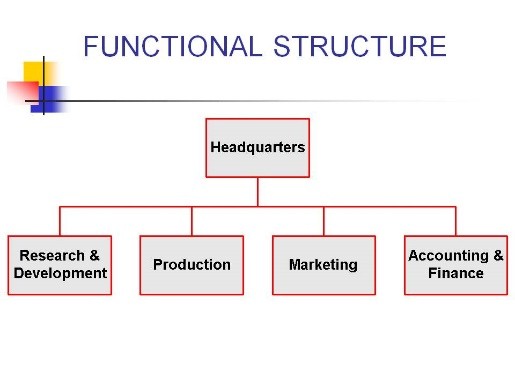Common Organizational Structures
An organizational structure defines how activities such as task allocation, coordination and supervision are directed toward the achievement of organizational aims. It can also be considered as the viewing glass or perspective through which individuals see their organization and its environment.
There are a number of factors that differentiate small-businesses from large-businesses. One of which is the organizational structure. The structure is important for any growing company to provide guidance and clarity on specific human resources issues, such as authority and responsibility. It is important for small-business owners to think about a formal structure in the early growth stage of the business. Organizations are outcomes of alternative clustered entities. An organization can be structured in many different ways, depending on its objectives. The structure of an organization determines the modes in which it operates and perform because it allows clarity in understanding allocation of responsibilities for different functions and processes to different entities such as the branch, department, workgroup and individual. Organizational structure affects organizational action in two big ways: first, it provides the foundation on which standard operating procedures and routines rest. Second, it determines which individuals get to participate in which decision-making processes, and thus to what extent their views shape the organization’s actions. It also clarifies roles played by individuals.
By applying mind to the organizational structure, departments can work more like well-oiled machines, focusing time and energy on productive tasks. A thoroughly outlined structure can also provide a roadmap for internal promotions, allowing companies to create solid employee advancement tracks for entry-level workers. Organizations structures are broadly termed as either formal or informal.
Formal organizations: These are organizations that follow well defined rules and regulation and have well-framed aims and objectives. These organizations do care for a status and have defined activities, roles for individual employees. Formal organizations follow strict observance of the principle of co-ordination and the messages are followed through scalar chain. The meaning of scalar chain is that a formal line of authority is followed from highest to lowest rank in a straight line. This chain specifies the route through which the information is to be communicated to the desired location/person.
You will find hierarchical work distribution and clear division of labor in formal organizations. It works on a fixed set of rules of intra-organization procedures and structures. The rules are in written and documented. The authority, responsibility, and accountability of individuals in the organization is very well defined. Hence, facilitating the co-ordination of various activities of the organization very effectively. We see more group cohesiveness in formal organizations.
Informal organizations: The informal organization is social structure which links different points of work and governs how people work together in practice. It is the collective result of norms, personal connection and professional connections through which work gets done and relationships are built among people who share a common organizational association, it is also a cluster of connections. Informal organizations work on a dynamic set of personal relationships, social networks, communities of common interest, and emotional sources of motivation. The informal organization evolves around social dynamics of its members (employees, management).
Informal organizations work like formal organizations but as the name suggests these organizations have informal atmosphere at work place and hence, it can accelerate and boost responses to unanticipated events, foster innovation, enable people to solve problems that require collaboration across boundaries, and create footpaths showing where the formal organization may someday need to pave a way. Informal organizations evolve constantly, they operate from grass root levels, and they are dynamic to responses. The atmosphere fosters innovation and they are excellent motivators. It treats people as individuals and not groups. Most importantly, informal organizations are fluid and flat which are bound by trust and reciprocity. The decision making process is mutual in these organizations.
Line or Staff Organizational Structure:
Line organization of business structure evolves with self-contained departments. In which, authority travels downwards from top and accountability travels upwards from bottom along the chain of command. Each department manager has control over his or her department’s affairs and employees. A line organization has only direct, vertical relationships between different levels in the firm. There are only line departments which are directly involved in accomplishing the primary goal of the organization.
Advantages:
- This structure inclines in simplicity because of its clarity. Command go from top to bottom and accountability travels from bottom to top.
- Authority and responsibility is better understood.
- Decisions are taken faster.
Disadvantages:
- The chain of command neglects talent. At times good ideas just die away as the capable people get lost in between the chain.
- Employees become bureaucratic in temperament.
- This structure overloads key persons.
Divisional Organizational Structure:
In this type of structure, the organization is divided on the basis in which departments are formed such as function, product, geographic territory, project and combination of these. Divisional structure is typically used in larger companies that operate in a wide geographic area or that have separate smaller organizations within the umbrella group to cover different types of products or market areas. While the divisions have control over their day-to-day operations, they still are answerable to a central authority that provides the overall strategy for the organization and coordinates its implementation among the divisions. Large corporations, especially large multinational corporations, utilize a divisional structure. For example, General Motors was one of the first companies to implement the divisional structure. This type of structure is also referred to as a multidivisional structure, or M-form, organization. The benefit of this structure is that needs can be met more rapidly and more specifically; however, communication is inhibited because employees in different divisions work in isolation. Divisional structure is costly because of its size and scope.
Functional structure: In a functional organizational structure, an organization’s reporting relationships are grouped based on specialty, or functional area. For example, separate departments for marketing, accounting, distribution, financing etc. Generally, all the functional heads report directly to the company president or CEO. A functional structure is one of the most common organizational structures. Under this structure, the organization groups employees according to a specialized or similar set of roles or tasks. While functional structures operate well in stable environments where business strategies are less inclined to changes or dynamism, the level of bureaucracy makes it difficult for organizations to respond to changes in the market quickly.
Advantages: Productivity increases. Specialization leads to operational efficiencies and enhances productivity levels. Because of their expertise, workers with specialized skills can perform tasks quickly, efficiently and with more confidence, thus reducing the occurrence of work-related mistakes. In addition, the clear nature of the career path within the functional unit makes it possible for employees to be highly motivated to advance their careers as they move up within the hierarchy. The main goal of functional structures in organizations is to bring the entire human and informational resources together to meet the organization’s goals.
Disadvantage: Rigidity sets in. Communication in organizations with functional organizational structures can be rigid because of the standardized ways of operation and the high degree of formalization. This can further make the decision-making process slow and inflexible. Since it is more bureaucratic, functional units are often not accountable to each other, and poor horizontal coordination within the departments can occur. Lack of innovation and restricted views of organizational goals, along with too much focus, can affect employees’ motivation.
Matrix Structure:
The Matrix organizational structure is a hybrid of divisional and functional structure. It is typically used in large multinational companies. The matrix structure allows for the benefits of functional and divisional structures to exist in one organization. This can create power struggles because most areas of the company is responsible for a dual management; a functional manager and a product or divisional manager usually work at the same level and cover some of the same managerial territory. The matrix organizational structure is different because it brings together employees and managers from different departments to work toward accomplishing a goal. Each task his carried out from the functional and divisional area. The former divides departments within a company by the functions performed, while the latter divides them by products, customers or geographical location. Small business owners should understand the benefits and limitations of the matrix structure before implementing it in their businesses.
Advantage: One of the advantages of implementing the matrix organizational structure in a business is that it can lead to an efficient exchange of information. Departments work closely together and communicate with each other frequently to solve issues. Efficient lines of communication enhance productivity and allow for quick decision-making. For example, in a matrix structure, individuals from the marketing, finance and product departments may confer with one another to formulate strategies. The specialized information exchange allows managers to respond quickly to the needs of customers and the organization.
Disadvantage: Internal conflict. Matrix structures result in internal complexity. Employees at times become confused as to who their direct supervisor is. It often seen that an employee receives different directions concerning the same thing from supervisors in different departments. The dual authority and communication problems cause division among employees and managers. Communication loses clarity and therefore policies lose their focus and set in employee dissatisfaction and low morale. Prolonged issues cause a high employee turnover.

















































